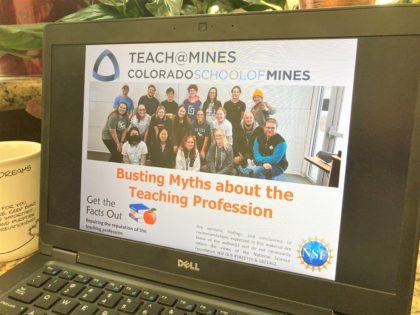 Busting Myths about the Teaching Profession
Busting Myths about the Teaching Profession
This page includes an interactive presentation designed to share the facts about the teaching profession with prospective teachers.
Audience/setting: Prospective STEM discipline teachers (undergraduate, graduate, alum). Appropriate for either a virtual or face-to-face setting.
Time: 15-30 minutes
Synopsis: This resource includes interactive presentation materials (PowerPoint slides and handouts) designed to facilitate discussion with students who may or may not be interested in teaching themselves, in a variety of contexts.
Materials
Use these materials during an interactive presentation such as an information session about careers, in a major or non-major course, a student club meeting, or a recruitment event. Please check back often to make sure you have the latest version.
*Presentations are continually refined, the date is in the title for each file.
Implementation
Steps to doing a presentation Checklist
- Pre-register your presentation.
- Find local Teacher Salary Data and modify the presentation.
- Look through the presentation. There are notes under each slide with explanations and suggestions.
- Add slides at the end about your program.
- Review how to credit GFO when modifying or using these resources.
- Log your activity and register as a GFO Champion if you have not already done so.
- Go Get the Facts Out!
Pre/Post Quiz Data and Analysis
Important note:
Giving both the pre quiz and the post quiz increases the audience learning and retention. The pre quiz provides a roadmap of what will be learned, some motivation to figure out the answers, and with 1. pre, 2. content, 3. post there are three reinforcements of these facts.
When thinking about how the brain works, this helps your audience focus on the ideas you’ll be discussing and it sparks their curiosity. Also it engages them and helps them cleanse their brain of what ever possessed it when they walked in the door. Finally, it helps you see how things went afterwards. We always joke that, “We’re starting by giving you a quiz. This will help you get some idea of the facts I’ll be sharing with you today and after the presentation, you should have the answers to these questions.”
Directions:
Due to a temporary lapse in NSF funding, we do not have the necessary resources to process the pre/post responses and data at this time that are submitted to the current survey links/QR codes in the slide decks above. You can create your own pre/post quiz in Survey Monkey or with a Google Form. Here are the questions that are used.
Once you have given and registered your presentation, you can start analyzing the results. Here is the template used for the analysis and a step-by-step video of the process.
Key Features to an Effective Interactive Presentation
Variations:
- 1 – 30 minutes in class
- 15 – 30 minutes club meetings, information session, ice cream social, residence life… (complete list is on the How to Reach Students page)
What are the intended outcomes of this presentation?
- The audience will have positive attitudes towards teaching as a profession.
- The audience will engage in ideas about teaching as a profession after the workshop (e.g., by reflecting, sharing, engaging in conversation).
- The audience will feel better prepared to make an informed choice about their career options, including teaching.
What should a presentation look like?
- The key message of Get the Facts Out is emphasized: Teachers in the U.S. rate their lives better than all other occupation groups, trailing only physicians.
- Accurate information about teaching as a profession is provided, including life satisfaction, salary, retirement, student loan forgiveness.
- Comparison to industry and college faculty is provided.
- Information on teacher salaries and retirement have been updated with local data.
What should you do as a presenter?
- Create a safe and fun space for students to engage, from the start.
- Share the positive aspects of teaching as a profession that are supported by data.
- Avoid voicing misperceptions about teaching as a profession.
- If students express misperceptions about teaching as a profession, provide fact-based corrections.
- Avoid providing airtime for anecdotal aspects of teaching as a profession (which are often negative and not supported by data).


